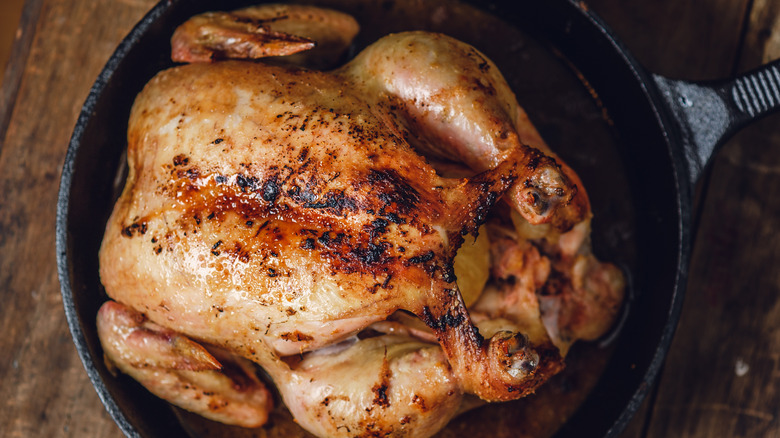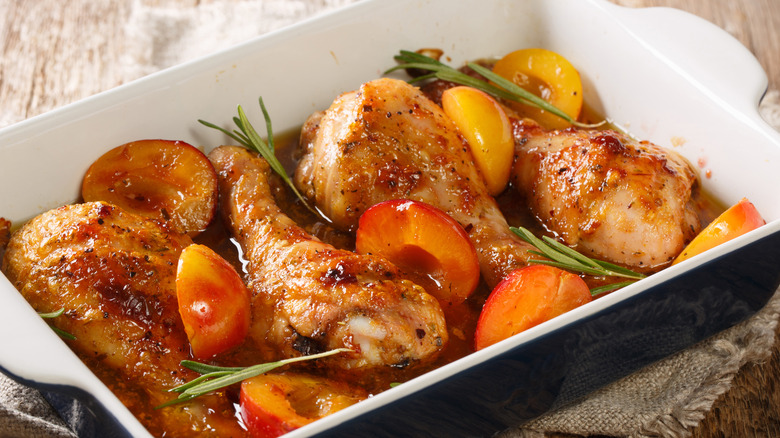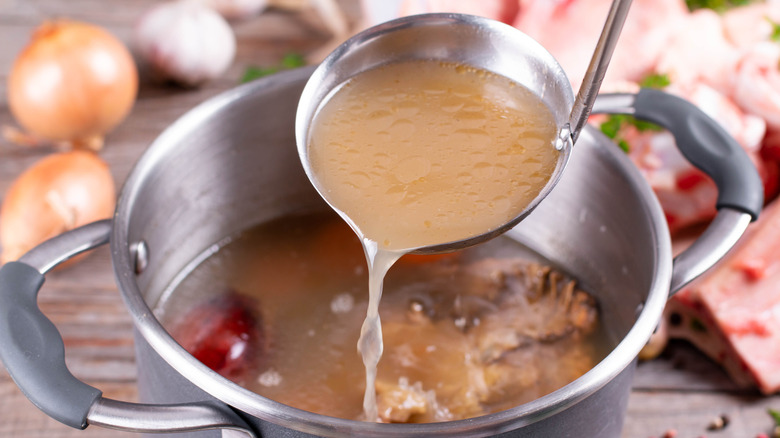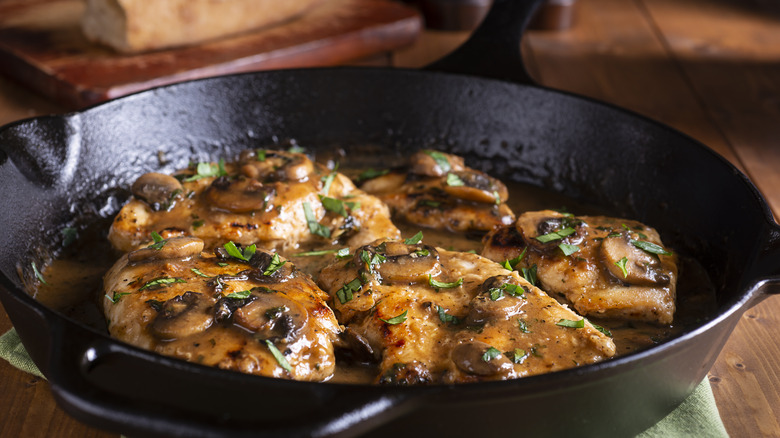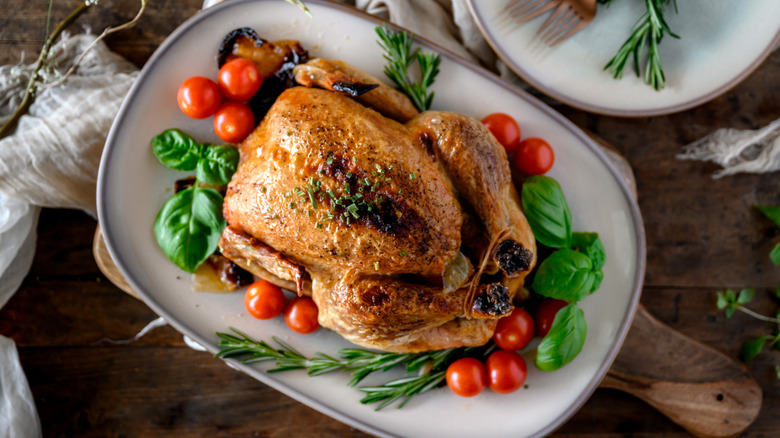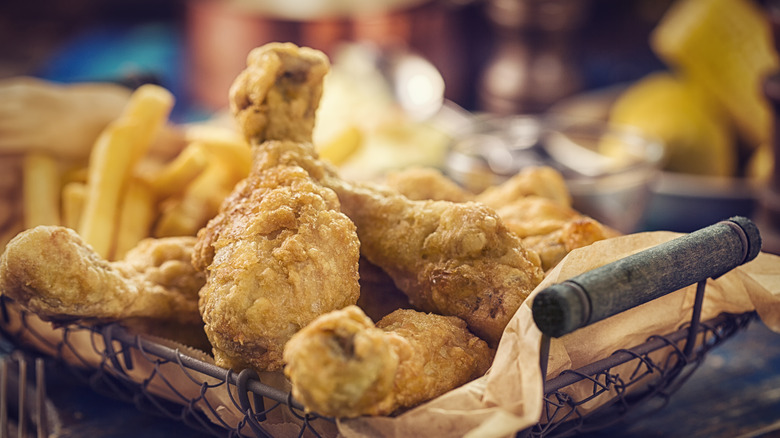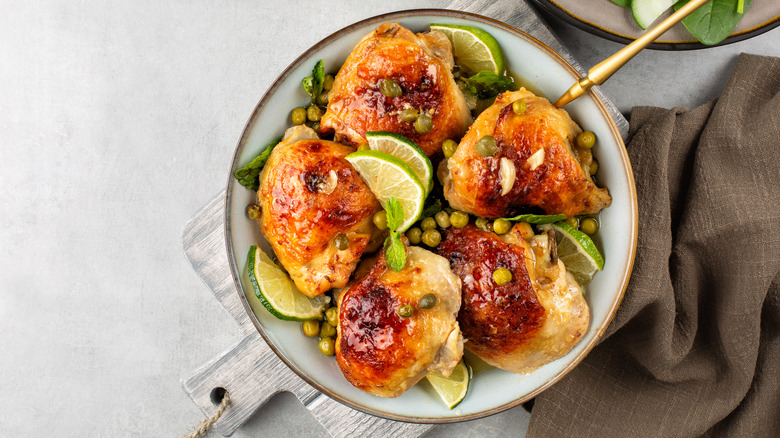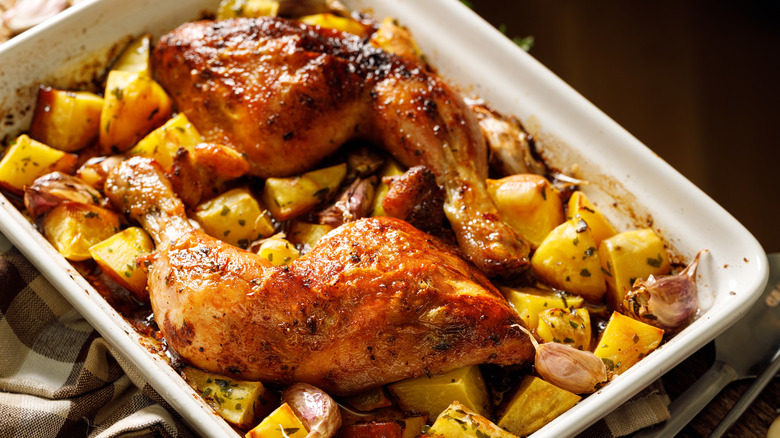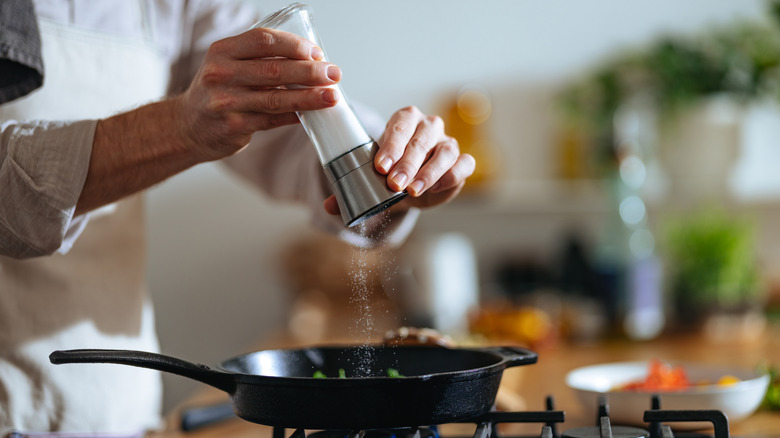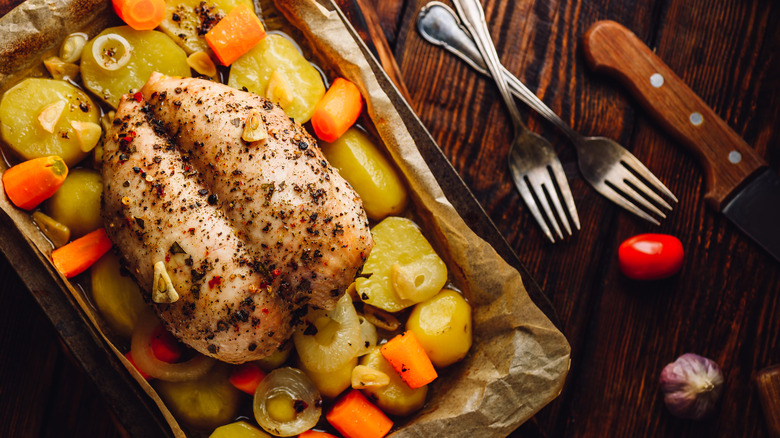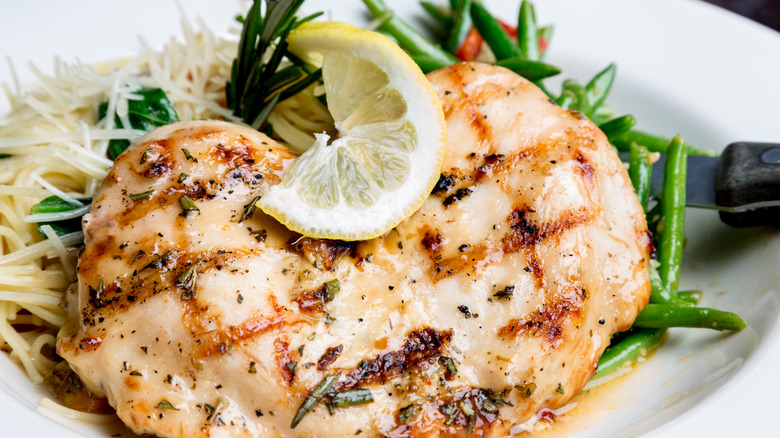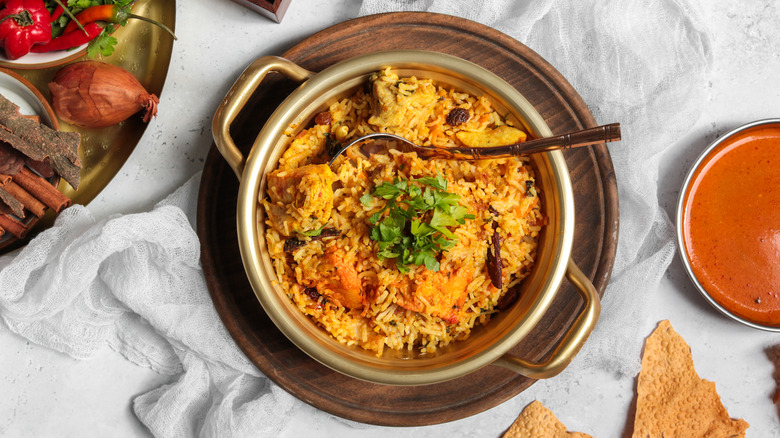Ina Garten's Best Tips For Cooking Perfect Chicken Every Time
We may receive a commission on purchases made from links.
Food Network superstar and all-around home cooking queen, Ina Garten knows exactly what she's doing in the kitchen. The Barefoot Contessa has endless advice for every cook, no matter their level of experience, and her recipes are straightforward, helpful, and incredibly delicious. From television shows to bestselling cookbooks, there is a wealth of fantastic gastronomic guidance in everything Garten touches.
A proponent of the ever-famous Engagement Roast Chicken (who would bother making any other recipe but hers?) in addition to a wide array of other decadent chicken dishes, Garten has cooked her fair share of poultry. The foodie icon is eager to share her tips and tricks on getting the best bites out of every chicken recipe, and if there's anyone to go to for cooking help, it's her. From how to get super delicious and crispy chicken skin to how to baste a bird to delectable perfection, her wisdom suits all skill levels.
Go for a smaller chicken
Even if the plan is to feed a crowd, a larger bird is not necessarily the way to go. When roasting a whole chicken in the oven, Ina Garten recommends selecting one that is no bigger than five pounds. Not only do smaller birds tend to roast much more thoroughly, younger chickens are naturally more tender and their meat retains a bit more flavor. Larger, older chickens have had time to develop more muscular meat, which can become tough when cooked and is not as succulent as younger, smaller poultry.
Any chicken bigger than six pounds can be tricky to cook evenly, and according to Garten "... they don't tend to roast as easily." So the next time you want to wow your guests with your culinary prowess, pick a bird that's four to five pounds and simply roast more than one depending on how many you're feeding. There's a better chance that the meat will be roasted to perfection. This can sometimes be a tough size to find in the average grocery store, so connecting with a local farm or butcher is the way to go.
Leave the skin on when cooking chicken
Even with recipes that call for skinless chicken, cooking with the skin on yields a moister, juicier bird with a far more satisfying flavor. Chicken skin contains natural fat, and when chicken is cooked with the skin on, all of that fat melts into the meat, providing a more tender texture as well as a better taste.
On the "Ask Ina" portion of her Barefoot Contessa website that invites readers and viewers to ask her for advice directly, Ina Garten says, "I always cook chicken with the skin on. I find it makes the meat much more tender and moist."
As for recipes that don't use skin or when you may be cooking for people who avoid it, Garten has a recommendation for those cases, too. "Even if you're going to remove the skin after cooking," she says, "I would recommend you roast the chicken skin-on and then remove the skin." Sounds good!
Save your scraps
Leftover chicken can easily be used for other recipes like chicken salad while bones and other extras can also be saved to make stocks and broths. Two of Ina Garten's favorite ways to repurpose chicken leftovers, according to a talk given during the New York Times Food Festival, are tacos and soups. Adding a few handfuls of shredded chicken to a taco meal or a simple soup recipe offers an extra dose of protein and some tasty flavor.
As for making homemade chicken stock, it's easier than a lot of people may think. Among Ina Garten's helpful tips is to hold onto the carcass after breaking down a whole chicken and boil it. Following her own recipe on Food Network, all that's needed are a few vegetables, herbs, water, and as many chicken scraps you have — and the recipe still works well even if you don't use all of the chicken meat. Garten swears by having stock on hand at all times. "I think of homemade chicken stock as liquid gold," she says in her cookbook "Modern Comfort Food" – "It gives anything you make with it rich body and aroma."
Pour sauce around the chicken, not over it
Once the chicken skin is beautifully crisp, the last thing anyone wants is for it to go soggy or lose its crunch. This is why it's best to incorporate any additional sauces very strategically.
Especially when using a wine-based sauce, Ina Garten is always careful to pour her sauces around the chicken rather than over the top of it. Not only does this protect the texture of the dish, it helps preserve any spices and flavors the chicken has already been infused with during cooking. Pouring sauce around the edges of the roasting pan or serving dish rather than directly over the meat also helps any chicken recipe maintain its color, important for recipes such as Chicken Marbella, which aims for a rich bronze hue.
Additionally, this trick allows the chef to maintain some control over how much of a new flavor to incorporate into the meal. When sauce is poured onto the chicken, it becomes difficult to determine how much of each bite will mostly taste like sauce. Pouring sauce around will give the eater control over how much they'd like with each bite.
Be careful not to overcook
A common kitchen woe is accidental overcooking, and this can be particularly tricky with chicken recipes. Even if the poultry itself doesn't burn or char, it can still be overcooked, which causes it to come out dry, tough to chew, and lacking in flavor.
Ina Garten suggests that every home oven be carefully assessed to ensure that the cooking temperature is accurate. As one fan wrote on the "Ask Ina" portion of Garten's website, when trying to make perfect roast chicken, the chicken came out too dry and the vegetables were charred even when the recipe was followed to the letter.
"First, I would use an oven thermometer to make sure your oven temperature is accurate," was Garten's sage advice. Many ovens are off by a few degrees, and this adds up when roasting meat for over an hour at a time. A small, simple oven thermometer can be found at most hardware or cooking stores and can help ensure that an oven is functioning properly.
Take your time for great fried chicken
Fried chicken can be used for dozens of meals, from chicken and waffles to a crispy lunchtime sandwich. Great fried chicken, though, takes a lot longer to get right than some may think. Nine hours may seem like an absurd amount of time to spend on a single chicken dish, but this succulent and flavorful recipe is absolutely worth it.
Ina Garten marinates her chicken in buttermilk overnight for a minimum of eight hours and as long as 24 hours. This enhances both the flavor and texture of every cut as the acidity in buttermilk incorporates a delicious tartness and the time spent marinating allows the chicken to become exceptionally moist and tender. Once the chicken has marinated to the cook's satisfaction, the rest of the process of making Garten's Buttermilk Fried Chicken goes much quicker, but the overnight soak is not to be skipped.
Don't overlook the cheaper cuts
When coming up with what to put together for dinner or when considering a new recipe, cost is a common factor. Ina Garten's repertoire allows for many levels of accessibility with the sheer range of options her cookbooks offer, but another element that is important to bear in mind when concocting one of her chicken dishes is that cheaper cuts of meat can easily suit plenty of those recipes.
Chicken thighs are sometimes overlooked in favor of the somewhat more popular chicken breasts. However, thighs are typically far less expensive in most grocery stores, and they are usually more tender and flavorsome parts of the bird than breasts are. In recipes such as Chicken Thighs with Creamy Mustard Sauce, Garten introduces tasty and elegant ways to dress up an otherwise less favorable part of the chicken in order to make an affordable meal that is just as delicious.
Always serve your chicken warm
This may seem like an obvious tip, but no chicken dish should ever be served cold. Once the chicken is done fully cooking in the oven or on the stovetop and has had time to rest, it's important to ensure it is still being served warm in order to preserve the flavor of the dish.
With recipes like Ina Garten's Skillet Roasted Chicken and Potatoes –when the skillet pulls double duty roasting both the chicken and the potatoes — this is sometimes a bit of a juggling act. Once the chicken is finished cooking, it should be transferred onto a plate and wrapped in aluminum foil so that the skillet can finish the potatoes. Once the potatoes are done and the skillet is still hot, the chicken returns to the skillet and is served from there so that all elements of the recipe are warmed to perfection.
Don't skip the salt
"Add salt to taste" is a common directive in many recipes, and even if home cooks prefer to avoid too much saltiness in their dishes, it's important not to skip it completely. Ina Garten's Chicken Soup suggests 2 tablespoons of Kosher salt to give the soup depth and flavor, while her Chicken Noodle Soup (made with her very own Chicken Stock recipe) adds a little more salt at a time each step of the way to bring the dish together.
Salt can always be adjusted to suit the eater's preferences, but be careful not to go without it altogether as skipping salt can leave a recipe bland and tasteless. Start with whatever amount the recipe initially recommends, then have a little extra on hand to add to the other ingredients as needed. This process will help flavors to develop more fully and give the dish much needed umami.
Pick the right roasting pan
Ina Garten's Engagement Chicken is a must for all kinds of special occasions, and while there are many elements to bear in mind while putting such an iconic dish together, the first is choosing the right roasting pan. Garten herself prefers a half sheet pan, which may seem unconventional, but the Barefoot Contessa knows what she's doing.
"I use aluminum sheet pans that you can buy at any cookware store," Garten says on her website. "... you don't want to roast the chicken in a pan that's too big. The pan should be just big enough to hold the chicken ..." A half sheet pan helps to cook the bird more evenly as the oven's heat can more easily penetrate all sides of the chicken, which also helps the skin become crispy. Furthermore, cleaning up a half sheet pan is so much easier than scrubbing a traditional roasting pan.
Add citrus right before serving
For chicken recipes that incorporate citrus, such as Ina Garten's Skillet-Roasted Lemon Chicken, adding any juice or zest should always come last in order to keep all of the flavors of the dish bright and fragrant. Garten recommends waiting until the chicken is done cooking and out of the oven before sprinkling lemon juice over the completed dish while it rests. Ideally, citrus juice or zest should be the very last thing to go on the chicken before it is eaten.
If citrus is added to a recipe too early, it risks becoming bitter if it cooks for too long. Adding it at the end not only ensures freshness, it also allows the tart sweetness of a lemon, lime, or orange to help balance the existing flavors of a chicken dish that have already been developed during cooking. While there are exceptions to every rule (Ina Garten's Tequila Citrus Chicken marinates the chicken in lime, lemon, and orange juices in advance), adding citrus at the end is a helpful hint to keep in mind.
Spice up your chicken with saffron
While there are hundreds of ways to put a fun and unique spin on classic chicken recipes, there are few methods as decadent and delicious as the addition of a few threads of saffron. As the world's most expensive spice, saffron isn't a common household ingredient by any means, but many grocery stores keep it in stock or it can be purchased online. Plus, saffron can be a real treat when a special occasion calls for it.
Ina Garten's Chicken in a Pot with Orzo starts with far more modest ingredients such as diced celery and carrots, but the fennel and saffron are what take the dish from humble to heavenly. Saffron not only adds mouthwatering flavor, but it also brings a rich aroma and a beautiful yellow color that lend a real "wow" moment to the presentation. Saffron can also bring out warmer spice notes in the recipe for a richer, fuller flavor.


